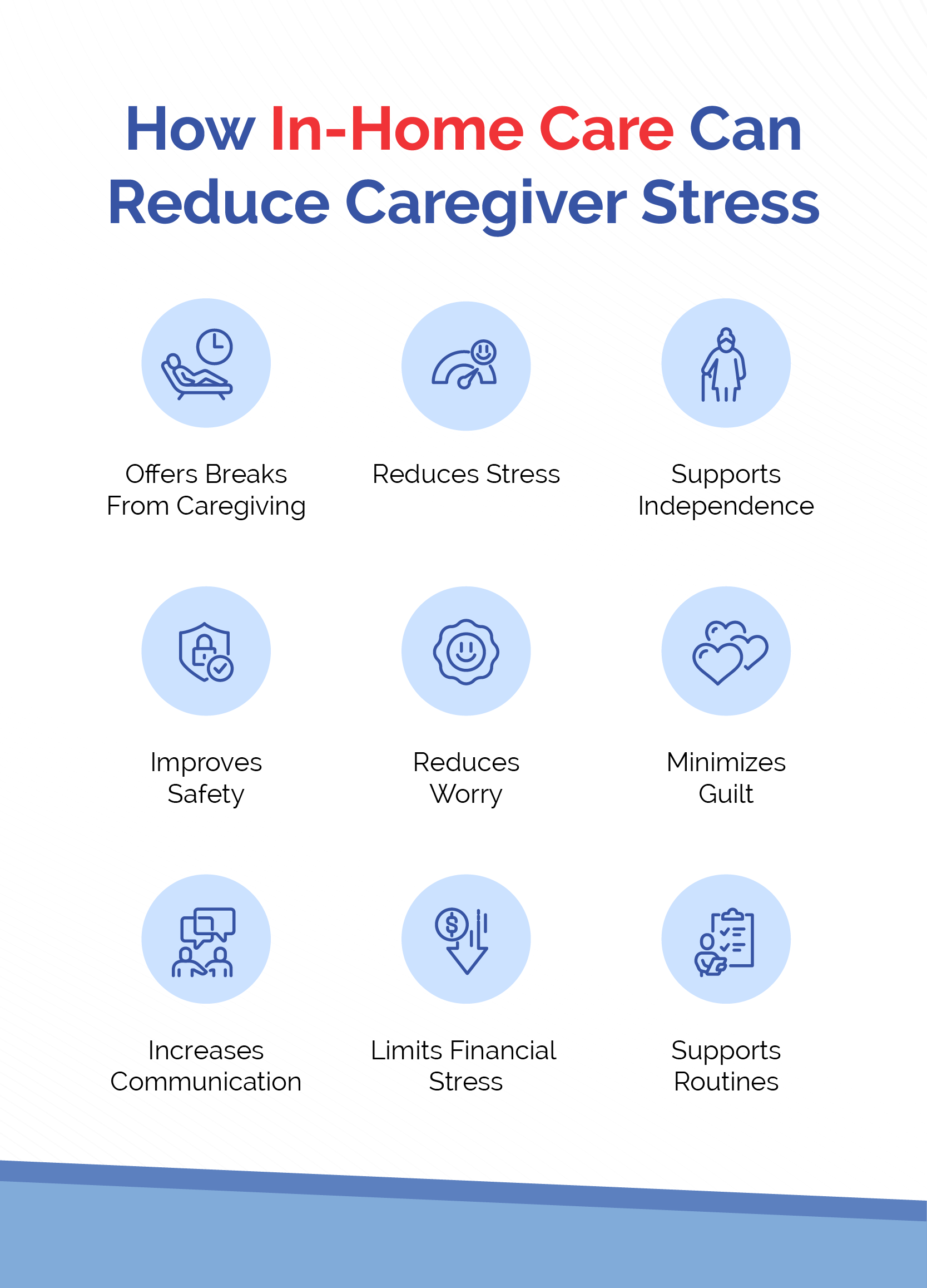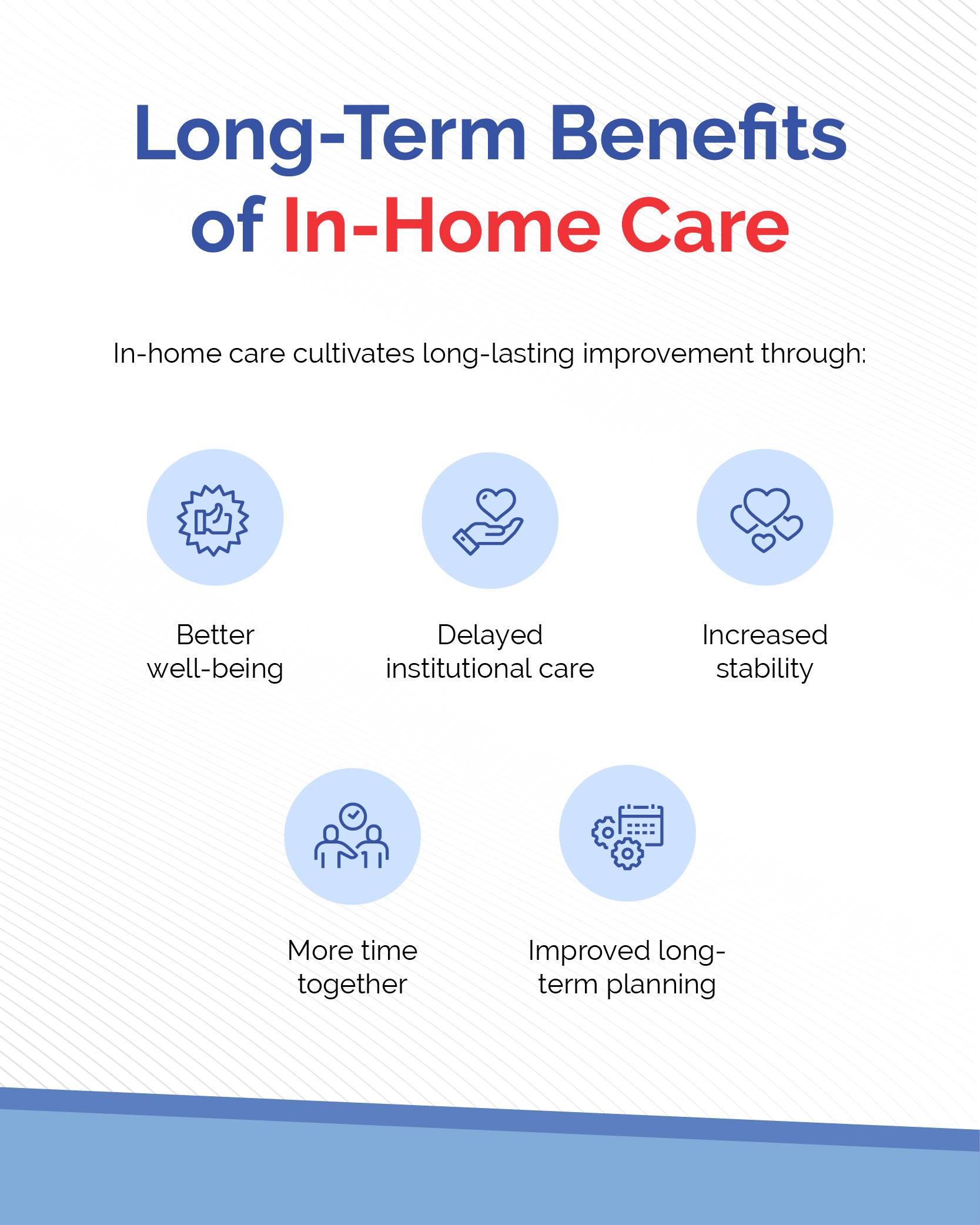Caring for an aging loved one keeps them at home in a familiar space around family. But caregiving can also be emotionally and physically challenging. Family caregivers often juggle care responsibilities and their jobs. This can lead to stress, which might affect their health and relationships.
In-home care offers families dedicated support, reducing stress and allowing older adults to stay at home. If you’re feeling stressed, there are support options that can help you watch out for your loved one. This guide from Village Caregiving explores how personal care services can limit caregiver stress while supporting older adults at home.
What Is In-Home Care?
In-home care is nonmedical assistance provided to people in their own homes. It’s common for older adults or those with chronic conditions. In-home care focuses on managing daily living tasks instead of offering medical support. Providers might come in once a day, get groceries or offer full-day support. Families can adjust homemaker service involvement as needed to fit their budget and loved one’s needs.
Home services might include light housekeeping, meal preparation, dressing support, mobility routines and transportation. In-home care can provide any nonmedical services an individual needs to get through their day. Family caregivers will tailor their services to each individual and their families so older adults can remain at home while staying comfortable.
What Is Caregiver Stress?
Caregiver stress is the strain that people who provide ongoing care might feel physically and emotionally. Caring for others while managing your own needs can increase stress. Aging parents or relatives with disabilities have unique care requirements and challenges — 50% of family caregivers see an increase in emotional stress since becoming support providers.
Due to stress, family caregivers might experience depression, anxiety, obesity, depression or chronic physical conditions. These pressures can lead to caregiver burnout. It’s important to prioritize your mental and physical well-being when acting as a support provider. Self-care is critical to reducing stress and improving everyone’s quality of living.
How Can In-Home Care Help Reduce Caregiver Stress?
Handling personal care tasks and dealing with emotional challenges can lead to stress. Family caregiving is usually the first step families take. Families want their loved ones to be comfortable. Family caregivers are often thinking about how to support older adults without moving them far away. But, over time, this can take a toll. Balancing work, family and caregiving is complex.
Your family can support older adults with professional assistance while maintaining close bonds and regular care. Here’s how in-home care reduces caregiver stress:

1. Offers Breaks From Caregiving
One of the biggest benefits of in-home care is the breaks it provides families. Whether professionals are working for a few hours or have long-term daily duties, family members get an immediate break to rest, handle personal tasks and recharge. Having a respite period gives you space to support your emotional and physical health.
These breaks also give families more freedom. Full-time caregiving can leave no time for balance. Families can use in-house care to maintain social connections, hobbies and exercise routines. They can relax and find balance again, now that their loved one is in responsible hands.
2. Reduces Stress
Add caregiving to household management, parenting and work, and you have a huge responsibility. Family caregivers often feel stretched thin. Managing another person’s daily life while keeping up with their usual schedule can lead to stress and burnout.
Professional providers assist with daily routines. With assistance for meals, housekeeping and transportation, families can rest or reconnect with friends. Fewer tasks on your plate means less stress and more time for yourself. In-home care also prevents family members from rushing between responsibilities or worrying about what they missed.
3. Supports Independence
Many older adults want to remain independent and in places they feel comfortable. At least 75% of Americans over 50 prefer to remain independent at home. Staying at home can feel more familiar and relaxing to loved ones. In-home care helps older adults maintain their current situation. When they feel independent, they’re less stressed and everyone at home feels better.
Personal care services help older adults make choices, do activities and relax in their own homes. Families don’t have to worry about relocation risks or institutional care. Older adults can continue to stay in contact with their community and enjoy the comfort of their own belongings.
Independence fosters collaboration at home. Families feel less like employees and more like loved ones.
4. Improves Safety
Safety is a major concern for families. Aging loved ones might fall when left alone or miss meals. These risks increase with mobility limitations or cognitive conditions like dementia. In-home care gives your loved ones long-term support and increases their safety at home.
While in-home care is not a safety guarantee, it can help reduce concerns. Constant support from a professional, paid family caregiver is an extra oversight. Busy family members might miss details that professionals notice. In-home assistants will monitor trip and fall hazards, or they can step in if a loved one is becoming confused. Small interventions make an impact on long-term safety and comfort.
In-home support can also reduce many families’ “what if” worries. With someone checking in regularly, assisting with movement or helping with daily routines, there’s less mental load to handle. Everyone gets a safer environment with less concern for all the hazards that might happen.
5. Reduces Worry
Loneliness and social isolation can increase the risk of depression and heart disease in aging adults. When families can’t be there every day, they worry about their loved one’s condition, safety and happiness. An in-home family caregiver provides companionship, which can reduce these worries.
In-home care is more than just helping with tasks. It’s access to another person who can provide social support. They talk with clients, take them on walks, share meals or practice hobbies. Having a constant, unstressed presence helps fill social gaps. Older adults get access to social interaction and a community, reducing their worry about loneliness.
Families can relax knowing their loved one isn’t alone all day. When you know there’s someone there, you can feel more at ease and ensure your loved one isn’t lonely. Use in-home care to complement your familial connection and keep worry to a minimum.
6. Minimizes Guilt
Family caregivers might also deal with feelings of guilt around loved ones. Family members who provide constant care might still feel like they aren’t doing enough. The internal pressure to always do more and be better can lead to stress and feelings of failure.
In-home care shifts your mindset from doing everything alone to building a support structure. Having a trusted professional provide companionship and task assistance creates a sense of shared responsibility.
It’s reassuring to see loved ones thrive with assistance. They might feel happier and more alert with their daily and emotional needs met by an in-home care provider. Family members start to see themselves as care coordinators, making thoughtful decisions for their loved ones. This approach eases guilt and is more beneficial to the older adult.
7. Increases Communication
Caregiving increases family responsibilities and, sometimes, tensions. It’s common to see uneven responsibilities among families. Maybe one sibling takes on most of the work and management. Other family members might feel sidelined or unsure how to help. Over time, unbalanced roles can lead to resentment and frustration. Exhaustion increases stress for everyone.
In-home care gives your family a professional third party who can help with communication. Outsourcing tasks like mobility or daily chores lets families focus on their relationships. Instead of feeling tension over roles, a paid professional handles some of the work. Families can communicate more effectively without resentment holding them back. They have more room to check in, discuss plans and share updates without baggage.
An in-home care provider is a constant communication source who keeps one family member from taking on all the stress. Plus, they have experience in this role. Professional family caregivers can help families navigate communication more easily while showing them how to handle an aging loved one.
8. Limits Financial Stress
In-home assistance offers families a cost-effective alternative to full-time institutions. Handling lost work hours, out-of-pocket expenses and long-term care costs can lead to financial stress. Supporting older adults at home with nonmedical services can delay more expensive care arrangements. There are government services and other programs that make residential care more affordable as well.
Homemaker services also provide flexibility. Only work with them as much as you can afford. There are full-time and part-time options to match your loved one’s needs and your financial situation. Keep your budget balanced while supporting your aging loved one. Your family can reduce financial stress with less time spent away from work or budgeting for facility care.
9. Supports Routines
Balancing work, family and a loved one’s care can make routines challenging. Structure provides aging adults and family caregivers with regular mealtimes, medication reminders and daily activities. Handling support alone can lead to missed events, forgotten meals and confusing schedules. As families fall out of routine, stress can increase.
Personal care minimizes uncertainty and lets families plan their schedules. Having a scheduled professional check-in on loved ones gives families more time to organize their lives. Families increase stability and reduce stress around providing support with a routine in place.
What Are the Long-Term Benefits of In-Home Care?
In-home care relieves stress, increases stability and supports long-term planning. It can provide loved ones with new connections and professional stability without leaving their homes. In-home care cultivates long-lasting improvement through:

- Better well-being: Ongoing stress takes a toll on your health. By splitting the caregiving work with a professional, families can reduce their stress and risk of stress-related health conditions.
- Delayed institutional care: In-home support can help older adults remain at home longer. Without in-home care, families might have to move loved ones to assisted living facilities against their wishes. In-home family caregivers allow loved ones to remain more independent in a space where they feel comfortable.
- Increased stability: Caregiving can lead to family strain and resentment. In-home care reduces family responsibilities. This support prevents tension and encourages family bonding.
- More time together: Being overwhelmed with caregiving can make engaging with your loved ones difficult. In-home care takes the work off your hands, so you can focus on quality time instead of being stressed.
- Improved long-term planning: Knowing you have help makes future planning easier. You have more room on your plate for organizing finances or watching gradual health changes. Families can make more informed, long-term decisions when they have professional support.
How to Determine if In-Home Care Is the Right Fit
If your loved one struggles with daily chores or you’re missing lots of work, it could be time for personal care services. However, with all the responsibilities on your plate, finding the right time to transition to in-home care can be difficult.
In-home care providers can start small, with weekly check-ins or grocery shopping, before moving to larger tasks. Gradually expand caregiving to a full-time role to ease everyone into the transition. If you’ve noticed these signs, it might be time to consider in-home care:
- Missed work: Have you been missing work frequently, or are you forgetting medical appointments? Missing important parts of your schedule is a sign you’re struggling to keep up. Having a professional care provider can take some responsibility off your shoulders.
- Withdrawn from activities: Are you feeling overwhelmed? Do you find yourself pulling away from social activities and family? Becoming disconnected from your support system can increase stress. Using a professional care team lets you take time for yourself.
- Physical or cognitive concerns: As loved ones age, they can experience mental or physical decline. Look for changes in weight, mobility or confusion. If your loved one seems distressed or forgetful, having professional support can make their life easier and more comfortable.
- Unkept space: Older adults may be unable to take care of their home as they used to. If there’s clutter, visible dirt or other chores piling up, they might need a helping hand.
Help Your Loved Ones Remain Comfortable
In-home care offers families structured support without sacrificing compassion. Professionals help families navigate the demands of caregiving while ensuring their loved ones are provided for. No one should have to carry the weight of full-time care alone. Reaching out for assistance gives you and your loved one more balance. In-home care can be as involved as you want, allowing your loved ones to live at home while reducing stress.


Recent Comments